Applications of the spontaneous light force
Spontaneous emission leads to a redistribution of momentum of an atom, absorbed from incident photons. Here, we discuss three applications of this spontaneous light force:
- Optical Molasses
- Beam Slowing
- Magneto-Optical Traps
Contents
The spontaneous light force
Consider a two-level atom with energy spacing , interacting with a single mode laser beam:
Let the laser intensity be , and the interaction matrix element between atom and light be , where is known as the Rabi frequency, is the electric field strength, and is the dipole moment of the atom.
It is useful to define a quantity known as the saturation intensity as the intensity of light at which the rabi frequency becomes , where is the spontaneous emission rate (the natural decay rate of the atom from to , excited to ground state). This gives
The rate at which photons are scattered from the atom is known to be
where is the frequency detuning of the laser from the center of resonance of the atom. Two useful limits of this scattering rate are
where we have assumed (resonant light). These expressions have a natural physical interpretation: in the limit of infinite intensity, the atomic levels become equally populated between the excited and ground state, and thus only half the atoms (the excited ones) can scatter light. Thus, the scattering rate is in that limit.
Suppose the force imparted by light on the atom is given by the recoil of photons spontaneously emitted from the atom. This force would then be
where is the momentum of each photon. This expression makes several assumptions: that is is the net momentum transfer in absorption, that there is no "stimulated" force, and that , meaning that the jump in the Doppler shift is less than the natural linewidth.
Typically, for alkali atoms, this force is times the mass of an atom ( being the acceleration due to gravity). This means that light can stop a sodium atom going at m/s in one millisecond, or about half a meter. In comparison to electrostatic forces on ions, this is very small, however: it is comparable to the force exerted by an electric field of 1 millivolt/cm on an ionized sodium atom.
Moving atoms experience a Doppler shift, which we can model as a frequency dependent force, based on Eq.(\ref{eq:ci:lorentzian}), as
where is the velocity of the atom. The effect of a fixed laser frequency on an ensemble of atoms is to modify their Maxwell-Boltzmann thermal velocity distribution:
Note how the initial distribution changes to one with atoms piling up below the velocity group resonant with the laser. The atoms bunch. Historically, this is the first method that was done to cool atoms to Kelvin temperatures.
One-dimensional optical molasses
Let us now turn to a method which allows cooling of atoms to zero velocity. Consider two laser beams incident on an atom from opposite directions. We assume that the total force is the sum of the two forces, ignore standing wave effects, and take the laser intensity to be low compared with the saturation intensity, . Taking the force to be the sum of two forces described by Eq.(\ref{eq:ci:vdf}), we find that the two lorentzians sum to give the following force as a function of velocity:
The velocity dependent force is positive from one light beam, and negative from the other. With a detuning chosen such that force is zero at zero velocity, the force around can be expanded linearly, giving
where describes the viscosity imparted by the light force to the atom, reflecting the restoring force applied when the atom is not at zero velocity. This configuration is known as an {\em optical molasses}, because of this restoring force, which makes the light behave like a thick, viscous medium for the atoms in it. The damping coefficient can be calculated to be
The Doppler cooling limit
We have seen that the spontaneous light force, characterized by the Lorentzian response of an atom to light, together with the Doppler shift due to movement of the atom, gives a velocity dependent force, which can be zero at zero velocity. Does this mean that the atoms can be cooled to zero temperature? If the rate of energy loss due to cooling is
then we should reach zero velocity, and zero temperature. Indeed, the kinetic energy decays exponentially. However, the spontaneous force has a random character, and thus has fluctuations which limit the minimum temperature achievable. This limit is determined by momentum diffusion. The force imparted can be described by a random walk. The final momentum is
on average, due to the random walk. Note that the momentum spread is
This describes heating which arises due to photons randomly scattering in all directions, such that the net momentum almost adds up to zero, but not quite. There is also a similar term due to absorption: some atoms will absorb more or less photons, due to the Poissonian statistics of absorption. Thus, the time variation of the kinetic energy due to the fluctuating forces is
where is the momentum diffusion coefficient
which we'll later see is a correlation function of the fluctuation forces. Let us now derive the Doppler limit for cooling. In equilibrium, . This means
The heating rate is independent of kinetic energy, whereas the cooling rate is a function of kinetic energy. So as the atoms cool down, the cooling rate slows down, resulting in a final temperature equilibrium being reached:
is a viscosity parameter: it reflects transport. reflects mobility. Thus, this is an Einstein relation, a universal expression in statistical mechanics resulting from the fundamental theorem which relates dissipation to fluctuations. We've now obtained an expression for the Doppler limit temperature, a limit on the temperature an ideal two-level atom can be cooled to by laser beams,
This optimal temperature is achieved for , and detuning of (half a linewidth). Physically, at low temperatures, the atom cannot determine whether the photon comes from left or right; at higher temperatures, the atom can discriminate whether photons come from left or right, thus cooling. For sodium, this temperature is K, corresponding to a velocity of cm/s.
Beam slowing
Let us now go back to slowing and atomic beams, in which we have many atoms and only one laser beam. If we have a Maxwell-Boltzmann distribution with atoms moving counterpropagating to the laser, the atoms' velocity distribution is pushed to lower velocities:
Note that in the Doppler cooling picture, we can only talk to atoms which are already pretty slow. From an atomic beam, however, there are hardly any atoms within this capture velocity range. It would be much nicer to collect atoms from the whole MB distribution; this is called beam slowing. Two stages are typically used: beam slowing, then Doppler cooling. We studied Doppler cooling first, because it was useful to get the concepts of the friction force and momentum diffusion. Beam slowing uses only one laser beam, but involves an extra twist in that we must first transform into a decelerating frame. Conceptually, the idea is to change the frequency of light applied as the atoms slow down, so that atoms continually experience a negative force. One way to accomplish this is to use multiple laser frequencies (white light slowing). Another is "diffuse light slowing" which uses light covering a large spectrum. Most efficient is to use a single frequency, and change the detuning of atoms with a magnetic field (re homework). We'll discuss "chirped slowing," because of its conceptual simplicity. It has little experimental use today, but was important in the mid 90's.
Chirped slowing
The idea behind chirped slowing is to get the atoms to "ride the surf". In other words, the frequency chirp of the laser beam and the deceleration of the atoms should be synchronized.
Balance of equations
Step 1
The force on an atom in the beam due to the light is
Let denote the atom's acceleration. Let us assume a frame of reference and experimental setup such that , , , . We can call , where is the atom's mass.
Step 2
The scheme begins by selecting the deceleration desired, some . Then set , and look for a to obtain this desired force. This will exist if
Step 3
Next, select an initial velocity such that . is the detuning for this "targeted" velocity group, so we must provide a laser with frequency in the lab frame of . The atom's velocity will differ from the desired target group by .
Step 4
With these definitions, we now have
in the frame of reference of the atoms in the target velocity group.
Step 5
Transforming into this decelerating frame, we get a fictitious force with is , and
This second term has the same structure as the first, but it is velocity independent. All we've done is to substitute definitions, so far, but they provide useful intuition.
Decelerating Frame
In the lab frame, we have a force which is a positive Lorentzian. In the decelerating frame, we had to add (the inertial force), so this Lorentzian shifts down:
Therefore, there is now a stable "lock" point, where as a function of . Thus, we may write, as we did with the molasses, an expression for the linearized force around this point, , in which . We may also calculate a momentum diffusion coefficient, and we'd find that , so that the final temperature limit of the beam is actually the same as that achievable with a molasses: .
We've seen that one laser can bunch up atoms from a beam at a single
velocity. Physically, what happens is that if the atoms fall behind,
the light does not interact with them, but if the atoms are too fast,
the laser cools them, much like in the molasses case.
Graphical summary
Here is a graphical summary of what we've learned about beam slowing. In the decelerating frame, this is the situation. Change sign, so that in the frame the decelerating force is positive, for this graph:
Initially, our zero force point is at the targeted velocity . All atoms at larger velocity experience a constant positive force, accelerating them. After a certain time , the tail of the maxwell-Boltzmann distribution is pushed to higher velocities:
similarly, all the atoms at lower velocities are pushed up in velocity until they stack up at , producing a narrow distribution around . The width of this narrow velocity distribution is proportional to .
Beam cooling is actually the simplest and cleanest example of laser cooling, because in the two-beam molasses case, one should really consider interference effects.
Energy versus momentum picture
Energy
Where did the energy go, in cooling the atoms? The energy was radiated away by spontaneous emission, as we shall now see. Light emitted by the atom is at the resonant energy , but can be absorbed when the photon is just slightly less than . The emission is isotropic, whereas the incident light is directed and Doppler shift dependent.
Doppler cooling can be explained in this picture. Laser light is detuned below ("red detuned"). The same intuition can be applied to solids and liquids. Phonon assisted absorption is balanced against emission, resulting in cooling:
How hard is it to cool liquids and solids? Consider a system at K; that gives the phonon energy. Then Kelvin. In practice, there is a lower than unity fluorescence quantum yield, because there are non-radiative ways to exit the excited state. The cooling will be efficient, however, only when the quantum yield is higher than , which is typically unrealistic. Cooling with laser light is therefore not typically practical, for systems other than atoms, which have a unity fluorescence quantum yield. Molecules are hard, because they have non-radiative de-excitation pathways.
3D molasses, high intensities
To cool atoms along not just one axis, but along three axes, use six counter-propagating laser beams. This configuration is called a 3D molasses. Everything we've discussed in one dimension can be applied; just sum up the forces. Some care must be taken, however, if interference patterns are created between the beams. As long as the atoms move a distance greater than the wavelength, interference may be neglected. But large field gradients can add extra forces and heating. One can also alternate between the six beams, but having simultaneous beams actually turns out to be good; it gives polarization gradients and other subtle effects which provide extra cooling. Landmark: in 1985, Steve Chu used chirped slowing and a 3D molasses configuration to obtain atoms colder than mK, for the first time.
Cooling at high intensities
Keep in mind that laser cooling works because and . Assume we have a detuning of about one linewith, . Now plot as a function of intensity:
First, increases as a function of intensity. Don't be confused by the fact that the Doppler limit is achieved at low intensities. The diffusion coefficient is also linear in intensity at low intensity. increases with at first, and peaks around , but above the saturation limit actually changes sign and starts heating. When then, counter-intuitively, blue detuned light can be used to cool atoms. This is a non-trivial result, which we'll return to later, and understand in the context of the optical Bloch equation and the dressed atom model.
Momentum and spatial diffusion
Momentum diffusion
First, consider diffusion of the momentum of an atom being cooled. The momentum diffusion coefficient is defined as
This can be directly calculated if we have a fluctuating force, using the fact that is a force:
showing that the diffusion is given by the integral of the force-force correlation function. Essentially:
This results due to the fluctuation-dissipation theorem.
Spatial diffusion
This is less frequently discussed in the literature compared with momentum diffusion, but it is of practical importance in experiments. Suppose the atoms start in a single point, embedded in a 3D optical molasses. How does the point distribution expand? On the time scale determined by , the atoms loose their memory of their original velocities. The molasses has a nearly perfect thermal distribution, despite atoms in the cloud never interacting with each other, because they thermalize to the laser beam. The damping time is
Spatial diffusion can be described by a random walk (in space), with a step size given by the RMS velocity of the atoms and the damping time,
where the extra factor of comes from a more rigorous treatment. Thus, starting from a point distribution, by the standard random walk result, after time , we obtain
where the number of steps is . This is
Now recall the definition
where is the spatial diffusion coefficient. This gives a relation between the spatial and momentum diffusion coefficients,
Note the similarity of this expression with the Einstein relation for carriers in semiconductors, . These expressions are useful in the laboratory context, as an example illustrates. How long does a typical trapped alkali atom (eg cesium or sodium) take to diffuse out by cm at the Doppler temperature? Using the formulas above, we get second. This is very accessible in the laboratory, and is one of the reasons why optical molasses are so useful in practice.
























![{\displaystyle F=\hbar k{\frac {\Gamma }{2}}{\frac {I/I_{0}}{1+{\frac {I}{I_{0}}}+2\left[{\frac {(2\delta +kv)}{\Gamma }}\right]^{2}}}\,,}](https://wikimedia.org/api/rest_v1/media/math/render/svg/42bb3f5ba0f906d1479b5cead54a946ba2c79425)

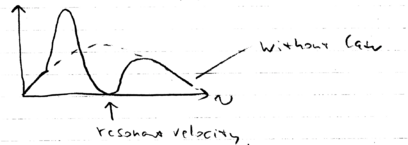

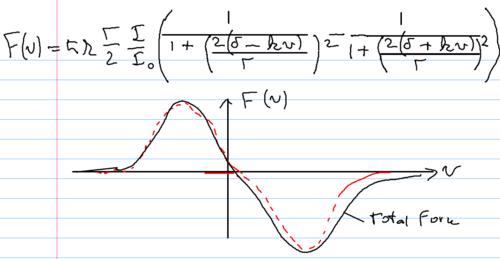



















![{\displaystyle F=-\hbar k{\frac {\Gamma }{2}}{\frac {I/I_{0}}{1+I/I_{0}+\left[{\frac {2(\delta +kv)}{\Gamma }}\right]^{2}}}}](https://wikimedia.org/api/rest_v1/media/math/render/svg/5dfb969d3cde2f98dcdf4cf800b63c3543426809)















![{\displaystyle F=-\hbar k{\frac {\Gamma }{2}}{\frac {I/I_{0}}{1+I/I_{0}+\left[{\frac {2(\delta '+kv')}{\Gamma }}\right]^{2}}}\,,}](https://wikimedia.org/api/rest_v1/media/math/render/svg/087622d4991f57f7abd12a596702081e4efe6480)

![{\displaystyle F'(v')=Ma_{max}\left[{\frac {I/I_{0}}{1+I/I_{0}+\left[{\frac {2(\delta '+kv')}{\Gamma }}\right]^{2}}}+{\frac {I/I_{0}}{1+I/I_{0}+\left[{\frac {2(\delta ')}{\Gamma }}\right]^{2}}}\right]}](https://wikimedia.org/api/rest_v1/media/math/render/svg/a0772bab6a738e2ee29b5c0ea76102175dfe6e28)

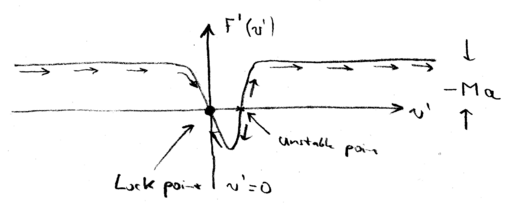






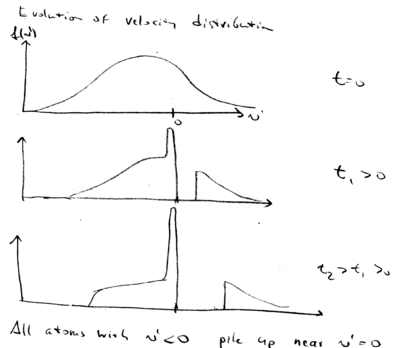

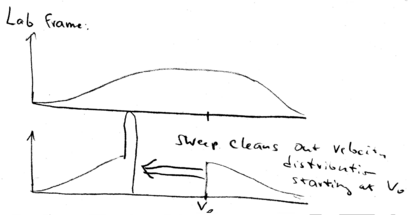










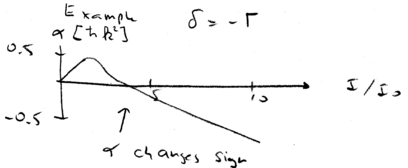





![{\displaystyle {\begin{array}{rcl}2D^{p}&=&{\frac {d}{dt}}\left[{\langle }{\vec {p}}\cdot {\vec {p}}{\rangle }-{\langle }{\vec {p}}{\rangle }{\langle }{\vec {p}}\rangle \right]\\&=&2\left[{\langle }{\vec {p}}\cdot {\vec {f}}{\rangle }-{\langle }{\vec {p}}{\rangle }{\langle }{\vec {f}}\rangle \right]\\&=&2\int _{-\infty }^{0}{\langle }{\vec {f}}(0)\cdot {\vec {f}}(t)\rangle -\langle {\vec {f}}(0){\rangle }{\langle }{\vec {f}}(t)\rangle \,dt\,,\end{array}}}](https://wikimedia.org/api/rest_v1/media/math/render/svg/02a7ffc7ff5cebc8f7bb85ff2b1089df0841cb45)













